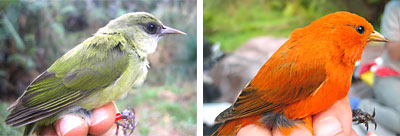

Native birds at Hakalau Forest National Wildlife Refuge on Hawaiʻi Island are in unprecedented trouble, and competition from an introduced bird species is likely to blame, according to veteran University of Hawaiʻi at Mānoa bird researchers.
Field studies by Professors Leonard Freed (zoology) and Rebecca Cann (cell and molecular biology) have documented lengthened and altered molts and declining survival rates in native birds since 2000.
The endangered Hawaiʻi creeper (Oreomystis mana) has experienced the widest prevalence of lengthened molt.
The researchers’ findings, which appear in a report published January 18 in the journal PLoS ONE, mirror the results of laboratory studies that have looked at the impact of starving birds under experimental conditions.
Native birds are taking longer to molt

The researchers found that both young and adult birds take up to twice as long to replace their feathers, an annual process known as molt. Young birds normally complete their juvenile molt in five months, beginning before June and ending in October.
Now it takes the birds as late as March of the following year to finish that molt. Adults are also taking that much longer to replace their feathers.
In addition, more adults are beginning their molt early, during months when they normally breed. Birds generally avoid this overlap in their life history because both activities require extra energy.
The endangered Hawaiʻi creeper had the greatest molting changes, Freed and Cann write. All Hawaiian honeycreepers had significant changes. In the most prolonged case, a Hawaiʻi ʻamakihi finished its juvenile molt from the previous year in March only to begin its adult molt in May.
Usually birds simultaneously molt the same primary flight feathers on both wings to maintain maneuverability. By 2002, all species had asymmetric molt of these feathers—the first time asymmetric molt was documented throughout a community of birds. In laboratory situations, starvation of birds to 60 percent of normal diet leads to the changes in molt that Freed and Cann observed in nature.
Japanese white-eye to blame

In the field, native birds died at a greater rate during the months of extended molt during 2000–04, and survival rates declined each year compared to a control set of years in the 1990s.
The data confirm that Japanese white-eye (Zosterops japonicus) birds are effectively competing with most species of native birds, Freed and Cann write.
Japanese white-eye birds were intentionally introduced to Hawaiʻi in 1929 to control insects. No trend in native bird survival was observed during the 1990s control years, when fewer white-eyes were present. Changes in molt during 2000–06 were associated in every detail with the increase in white-eyes.
The white-eye overlaps foraging areas with native species and spends much time gleaning insects and other prey on the same ubiquitous ʻōhiʻa lehua foliage used by most native species.
The latest findings complement a 2009 Current Biology paper by the authors, which showed that all species of native birds have stunted growth and lower survival.
Freed and Cann suggest that no section of the refuge is safe from the competitive effects of the introduced bird, especially the lower closed forest section of the refuge, which had the greatest non-normal molt in 2006.
Read their paper, Changes in Timing, Duration, and Symmetry of Molt of Hawaiian Forest Birds.

